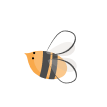- 6 months ago
First Aid at Home for Babies and Children
What Is First Aid—and What Isn’t?
First aid is immediate care given in an emergency before professional help arrives. It is not about diagnosing or curing—it’s about:
- Protecting life
- Preventing the situation from worsening
- Supporting recovery until medical help is available
Being prepared can turn panic into purposeful action.
Common Home Emergencies and First Aid Steps
Falls and Head Bumps
- Don’t move the baby—observe carefully
- If conscious and alert, monitor for 24 hours
- Apply a cold compress to swelling for 10–15 minutes
- If vomiting, drowsiness, or confusion occur—seek emergency care
Burns (Hot liquids, sun, surfaces)
- Cool the area under lukewarm (not icy) water for 20 minutes
- Do not apply creams, butter, toothpaste, or ice
- If clothing is stuck to the skin, do not remove it
- Cover with a clean cloth or sterile pad and see a doctor for deeper burns
Febrile Seizures
- Lay the child on their side in a safe, flat space
- Don’t put anything in their mouth
- Time the seizure: if it lasts longer than 5 minutes, call emergency services
- After the seizure, consult a doctor—even if your child seems fine
Nosebleeds
- Have the child sit upright with the head slightly forward
- Pinch the soft part of the nose for 10 minutes
- Do not tilt the head back or lie down
- If bleeding continues beyond 15 minutes, seek medical help
Choking or Swallowing Foreign Objects
-
Under 1 year:
-
5 back blows (with head facing downward)
-
5 chest thrusts
-
-
Over 1 year:
-
Perform the Heimlich maneuver
-
-
If the object comes out and breathing resumes, still visit a doctor
-
If the child is not breathing, begin CPR and call emergency services
What Should Be in Your Home First Aid Kit?
|
Item |
Purpose |
|
Sterile gauze pads |
Covering wounds, absorbing bleeding |
|
Elastic bandage |
Sprains or support |
|
Digital thermometer |
Monitoring fever |
|
Cold pack (instant or reusable) |
Swelling and bruises |
|
Antiseptic wipes or solution |
Cleaning wounds |
|
Tweezers |
Removing splinters |
|
Disposable gloves |
Infection control |
|
Nasal aspirator |
Easing baby’s breathing |
|
Fever-reducing medicine |
Only under medical guidance |
When to Call Emergency Services (e.g., 112)
- Breathing difficulty, bluish lips
- Loss of consciousness or seizures
- Severe burns or electrical shock
- Heavy bleeding or suspected broken bones
- Persistent choking or swallowed foreign objects
- Seizures lasting more than 5 minutes
Stay calm and clearly explain the situation and location.
First Aid Support with Dr. Ekin Pasinlioğlu
- Parent education on age-specific first aid
- Customized first aid kit checklist for your home
- Guidance for common baby and toddler emergencies
- How to respond to fever, falls, injuries, or poisoning
- School and daycare emergency plan preparation
- Referrals to pediatric emergency specialists when needed













